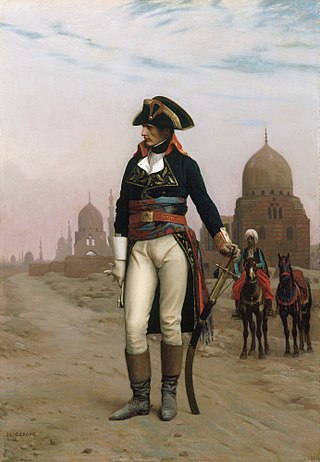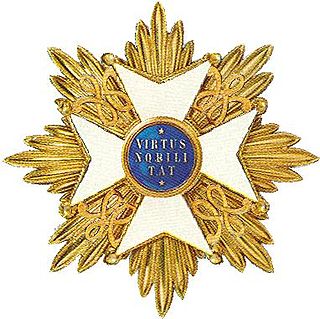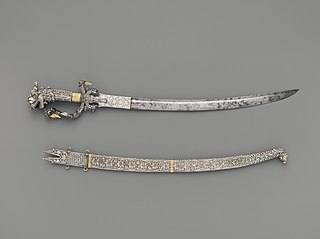
Wilhelmina was Queen of the Netherlands from 1890 until her abdication in 1948. She reigned for nearly 58 years, making her the longest-reigning monarch in Dutch history, as well as the longest-reigning female monarch outside the United Kingdom. Her reign saw World War I, the Dutch economic crisis of 1933 and World War II.

The Military William Order, or often named Military Order of William, is the oldest and highest honour of the Kingdom of the Netherlands. It is named after St. William of Gellone (755–814), the first Prince of Orange. Its motto is Voor Moed, Beleid en Trouw. The chivalric order was established on 30 April 1815 by King William I and was presented for feats of excellent bravery on the battlefield and as a meritorious decoration to senior military officers. Comparable with the French Légion d’Honneur but far less often awarded, it is open to everyone regardless of rank or nobility—not only to Dutch military, but also to foreigners. To date, membership in the Order is extremely rarely awarded, and only for exceptional bravery in battle.

Joannes Benedictus "Jo" van Heutsz was a Dutch military officer who was appointed governor general of the Dutch East Indies in 1904, years after he had become famous for bringing to an end to the long Aceh War.

A Mameluke sword is a cross-hilted, curved, scimitar-like sword historically derived from sabres used by Mamluk warriors of Mamluk Egypt after whom the sword is named. Egypt was, at least nominally, part of the Ottoman Empire and the sword most commonly used in Egypt was the same as used elsewhere in the empire, the kilij.

The shashka or shasqua is a kind of North Caucasian sabre; a single-edged, single-handed, and guardless sabre. The comparatively gentle curve of a shashka blade puts the weapon midway between a typically curved sabre and a straight sword, effective for both cutting and thrusting.

The Pattern 1908 cavalry trooper's sword was the last service sword issued to the cavalry of the British Army. It has been called the most effective cavalry sword ever designed, although its introduction occurred as swords finally became obsolete as military weapons. In use, it, like other thrust-based cavalry swords, is best described as a one-handed lance, due to its complete lack of utility for anything but the charge. In fact, the closely related US Model 1913 Cavalry Saber was issued with only a saddle scabbard, as it was not considered to be of much use to a dismounted cavalryman. Colonial troops, who could expect to engage in melee combat with opposing cavalry frequently carried cut and thrust swords either instead of, or in addition to, the P1908/1912.

The klewang or kelewang is a category of traditional single-edged sword that can be found throughout the Malay Archipelago. Usually it is shorter than a pedang (sword) but longer than a golok (machete). There are straight bladed types, but most are curved.

In the Dutch honours system, most orders are the responsibility of ministers of the Netherlands Government. The house orders, however, are awarded at the discretion of the Dutch monarch alone.
The Cross for Courage and Fidelity is a military award that was established by Queen Emma of the Netherlands by Royal Decree on 7 March 1898. The cross replaced the old Medal for Courage and Fidelity, which had limited prestige and status according to the Netherlands government. The cross is the second highest award of the Kingdom of the Netherlands, preceded only by the Military William Order. The cross was awarded to natives of the Netherlands East Indies that showed exceptional display of bravery and fidelity.
The Honorary Medal for Charitable Assistance was created at 18 June 1822 and is after the Military William Order the oldest decoration for bravery in the Kingdom of the Netherlands. Furthermore, the Honorary Medal is the highest civilian decoration still being awarded for bravery, and is specifically for those who carried out a voluntary act of bravery or self-sacrifice, with an emphasis on charity.
Albert Alberts, writing as A. Alberts (1911–1995) was a Dutch writer, translator, and journalist. He won numerous awards throughout his career, among them the 1975 Constantijn Huygens Prize.

A kastane or kasthane is a short traditional ceremonial or decorative single-edged Sri Lankan sword. The sword is featured in the Flag of Sri Lanka.

HNLMS Koningin Wilhelmina der Nederlanden was a unique protected cruiser of the Royal Netherlands Navy built by the Rijkswerf in Amsterdam.

Gotfried Coenraad Ernst "Frits" van Daalen was a Dutch military officer of the Royal Dutch East Indies Army who served as the Governor of Aceh from 1905 until 1908. During the Aceh War, van Daalen and his men were responsible for the Kuta Reh massacre, in which hundreds of men, women, and children were killed.

The Netherlands Red Cross was founded in 1867. It is among the Red Cross and Red Crescent Societies. It adopts branch governance structure which leads to approximately 214 branches that enables it to serve the whole country.

HNLMS Holland was a Holland-class protected cruiser of the Royal Netherlands Navy.

Major Kenneth George Mayhew was a British Army veteran of the Second World War. Mayhew was one of the recipients of the Military William Order, the highest honour of the Kingdom of the Netherlands.

The royal mantle of the Netherlands is worn only by the Dutch monarch at their inauguration. As the Dutch monarch is never crowned but inaugurated, its more appropriate to speak of a royal mantle than a coronation mantle.

The history of Suriname during World War II was mainly focused on protecting the bauxite industry and guarding the borders with French Guiana which was part of Vichy France. From November 1941 onwards, 2,000 American troops were stationed in Suriname who transformed Airstrip Zanderij into a major airport, and constructed defensive works. No actual battles took place in Suriname. There was a political crisis in 1943, because Governor Johannes Kielstra used the state of emergency to imprison political opponents.

















